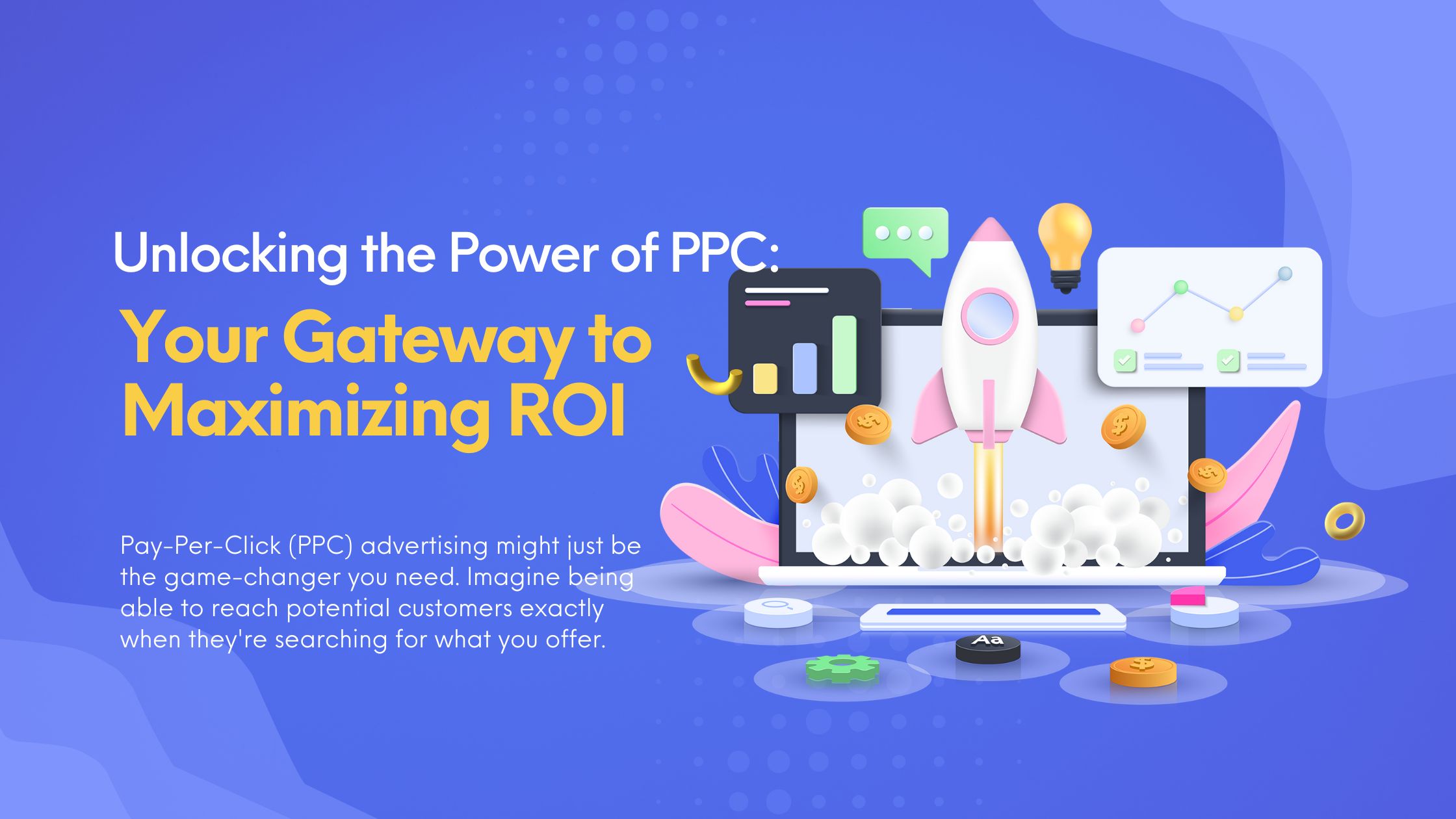Unlocking the Power of PPC: Your Gateway to Maximizing ROI
Pay-Per-Click (PPC) advertising—a dynamic and results-driven approach that not only boosts visibility but also drives qualified traffic right to your doorstep. In this blog post, we’ll dive deep into the strategies that transform PPC from a mere cost into a powerful engine for growth. Whether you’re a seasoned marketer or just starting out, discover how to harness the full potential of PPC campaigns and turn clicks into conversions like never before!
Introduction to PPC Advertising
If you’re looking to give your business a boost, Pay-Per-Click (PPC) advertising might just be the game-changer you need. Imagine being able to reach potential customers exactly when they’re searching for what you offer. With PPC, that dream becomes a reality. It’s like having a direct line to your target audience, and it can transform how you connect with them.
In today’s digital landscape, where competition is fierce and attention spans are short, standing out requires smart strategies. PPC not only drives traffic but also provides measurable results that let you see exactly what works—and what doesn’t. Whether you’re a small startup or an established enterprise, understanding the ins and outs of PPC can help maximize your return on investment (ROI).
Ready to dive into the world of PPC? Let’s explore how this powerful tool can elevate your marketing strategy and deliver impressive returns!
Benefits of Using PPC for Your Business
PPC advertising offers immediate visibility for your business. Unlike organic strategies, which can take time to build momentum, PPC allows you to appear at the top of search results almost instantly.
This method is highly targeted. You can reach specific demographics based on location, interests, and even online behavior. Tailoring your ads ensures they resonate with potential customers.
Another significant benefit is cost control. With PPC, you set a budget that suits your needs. You’re only charged when someone clicks on your ad, making it easier to manage expenses and measure effectiveness.
Additionally, the ability to track performance in real-time enhances decision-making. Metrics like click-through rates and conversion rates provide valuable insights into what works and what doesn’t.
Lastly, PPC campaigns are easily scalable. Whether you’re looking to expand or refine your efforts, adjustments can be made quickly without losing traction in other areas of marketing.
Understanding ROI in PPC Advertising
Return on Investment (ROI) is a crucial metric in the world of PPC advertising. It measures the effectiveness of your ad spend by comparing revenue generated to costs incurred.
To calculate ROI, you can use this simple formula: (Revenue – Cost) / Cost x 100. A positive ROI indicates that your campaigns are profitable. However, understanding what constitutes success varies among businesses.
Some may prioritize immediate sales, while others focus on brand awareness or lead generation. Each goal requires different strategies and metrics for evaluation.
Tracking conversions is vital as it helps gauge how well your ads are performing against their goals. Using tools like Google Analytics provides insight into user behavior after clicking through an ad.
Ultimately, a clear grasp of ROI empowers you to make informed decisions about budget allocation and campaign adjustments for better performance in future endeavors.
Tips for Maximizing ROI in PPC Advertising
Setting clear goals is paramount. Define what success looks like for your campaign, whether it’s increased sales, lead generation, or brand awareness.
Next, invest time in keyword research. Choose relevant keywords that align with user intent and have a healthy search volume but low competition to get the best bang for your buck.
Crafting compelling ad copy is essential too. Highlight unique selling points and include strong calls-to-action to encourage clicks.
Don’t neglect landing pages; they should be optimized for conversions as well. A seamless experience from ad to page increases the chances of engagement.
Monitoring performance regularly can make all the difference. Analyze metrics such as click-through rates and conversion rates frequently, adjusting bids and strategies based on real-time data will help keep your campaigns effective.
– Setting Clear Goals and Objectives
Setting clear goals and objectives is the cornerstone of any successful PPC campaign. Without a defined target, your efforts can feel aimless.
Start by identifying what you want to achieve. Are you looking to increase sales, boost brand awareness, or generate leads? Each goal requires different strategies and metrics for measurement.
Next, make those goals SMART—Specific, Measurable, Achievable, Relevant, and Time-bound. A vague objective like “get more clicks” needs refining. Instead, aim for something like “increase website traffic by 20% in three months.”
Prioritize these objectives based on their impact on your business. Focus on high-value targets that align with your overall marketing strategy.
Remember to communicate these goals clearly across your team. Everyone should understand the direction of the campaign so all efforts are cohesive and focused toward common aims.
– Keyword Research and Selection
Keyword research and selection is the backbone of any successful PPC campaign. It starts with identifying terms that your target audience frequently searches for. Think about their needs, interests, and pain points.
Tools like Google Keyword Planner can help you discover popular keywords related to your business. Look for a mix of high-volume and long-tail keywords. While high-volume keywords attract more traffic, long-tail options often have lower competition and better conversion rates.
Consider the intent behind each keyword as well. Are users looking to buy something immediately or just gathering information? Tailoring your ads to match user intent increases the likelihood of conversions.
Finally, always keep an eye on trends in search behavior. Regularly update your keyword list based on performance metrics and changes in consumer interest to stay ahead in the game.
– Crafting Effective Ad Copy and Landing Pages
Creating compelling ad copy is all about capturing attention quickly. Use strong, action-oriented language that resonates with your target audience. Ask yourself: what problem does my product solve? Highlight benefits instead of features.
Pairing this with a well-designed landing page enhances user experience. The landing page should echo the ad’s message and maintain visual consistency. This builds trust and encourages conversions.
Keep it simple on the landing page. A clear call-to-action (CTA) guides visitors toward their next step—be it signing up or making a purchase. Use engaging visuals to complement your text, but don’t overwhelm users.
Don’t forget to test different versions of both ads and landing pages. Small tweaks can lead to significant improvements in performance over time, helping you discover what truly resonates with your audience’s needs and preferences.
– Monitoring and Adjusting Your Campaigns
Monitoring your PPC campaigns is crucial for success. Regularly checking performance metrics allows you to see what’s working and what isn’t.
Use tools like Google Analytics to track clicks, conversions, and cost-per-acquisition. These insights help identify trends and areas needing improvement.
Adjusting bids based on performance can optimize your budget. If certain keywords are underperforming, consider reallocating funds to those that deliver better results.
Don’t forget about A/B testing. Experiment with different ad copies or landing pages to find the most effective combinations.
Keep an eye on competitors as well. Their strategies may provide fresh ideas or highlight gaps in your approach.
Finally, adapt quickly to seasonal changes or market shifts. Stay agile so you can pivot when necessary—this responsiveness can significantly boost your ROI over time.
Common Mistakes to Avoid in PPC Advertising
PPC advertising can be a powerful tool, but many businesses stumble due to common pitfalls. One major mistake is neglecting keyword research. Choosing irrelevant keywords leads to wasted budget and poor targeting.
Another frequent error is ignoring ad copy quality. If your ads aren’t compelling, users won’t click on them. Focus on clear messaging that highlights the unique benefits of your offering.
Landing pages are equally crucial. Sending traffic to generic pages can frustrate potential customers and increase bounce rates.
Additionally, some advertisers set campaigns and forget about them. Regular monitoring helps you spot trends, manage budgets effectively, and adjust bids as needed.
Lastly, failing to track conversions can blind you to the real success of your campaigns. Without this data, it’s impossible to determine what strategies work best for maximizing ROI in PPC efforts.
Case Studies: Successful Examples of Maximizing ROI through PPC
One standout case is a small e-commerce business specializing in eco-friendly products. They implemented PPC campaigns focused on sustainable keywords. Within three months, their ROI skyrocketed by 200%. Targeted ads drove significant traffic to their site, converting casual visitors into loyal customers.
Another compelling example comes from a local service provider. By utilizing geographic targeting and ad scheduling, they optimized their budget efficiently. Their strategic approach led to a 150% increase in lead generation within six weeks.
A well-known software company also made waves with its PPC strategy. By continuously A/B testing ad copy and landing pages, they discovered what resonated best with potential clients. This method resulted in reduced cost-per-click while enhancing conversion rates significantly.
These examples reveal the power of tailored strategies in maximizing PPC returns across various industries.
Conclusion: Why You Should Consider Implementing PPC in Your Marketing Strategy
When considering your marketing strategy, PPC advertising stands out as a powerful tool. It offers immediate visibility and the chance to reach potential customers right where they are searching for products or services like yours. The ability to target specific demographics allows you to tailor your message effectively.
The benefits of PPC extend beyond just driving traffic. With careful planning and execution, you can maximize your return on investment significantly. By setting clear goals, conducting thorough keyword research, crafting compelling ad copy, and continuously monitoring performance, you’ll position yourself for success.
Avoiding common pitfalls will also enhance your campaign’s effectiveness. Learning from successful case studies can provide inspiration and insights into what works best in various industries.
Implementing PPC could very well be the competitive edge you need in today’s digital landscape. As businesses increasingly turn to online channels for growth, harnessing the full potential of pay-per-click advertising is more crucial than ever before. Consider integrating it into your marketing mix and watch how it transforms your outreach efforts.




